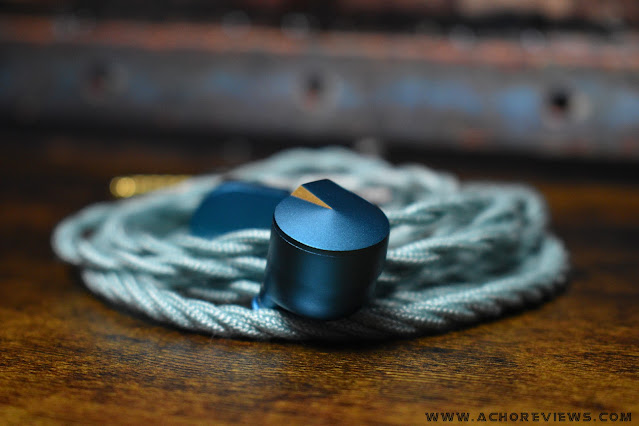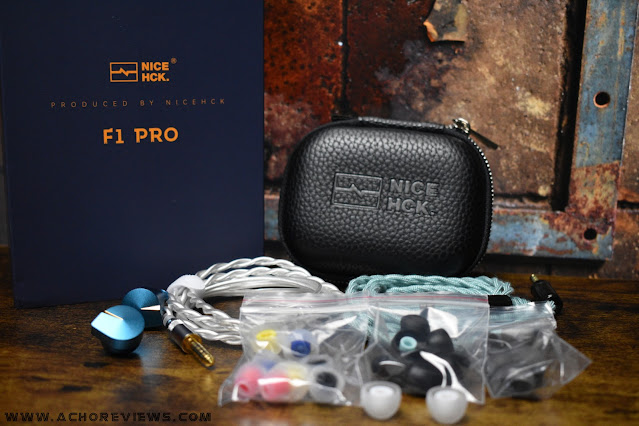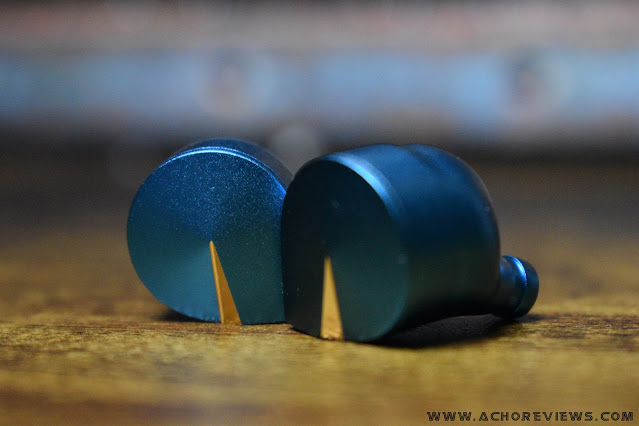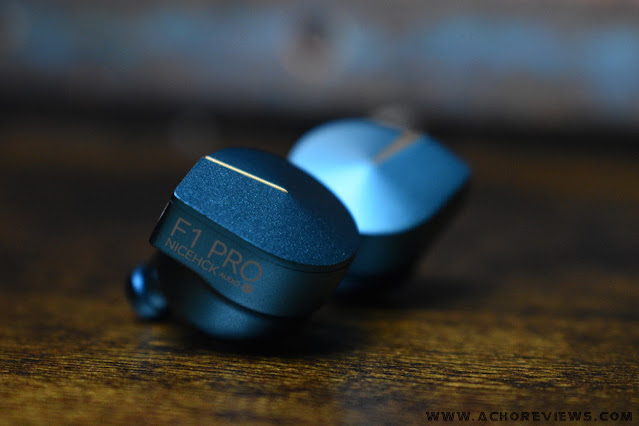- Get link
- X
- Other Apps
English | Español
TLDR version on YouTube: TDLR - NiceHCK F1 Pro
The F1 Pro have been sent to me directly from NiceHCK for me to try them out and share my opinions in this review. NiceHCK have not made any requests regarding the review and I will do my best, as usual, to be as unbiased as possible.
You can find the F1 Pro on the official NiceHCK store on AliExpress here: https://es.aliexpress.com/item/1005006228604236.html?gatewayAdapt=glo2esp
F1 Pro on Amazon US: https://www.amazon.com/dp/B0CSW8D8JG
As always, this is a non-affiliate link.
To avoid being repetitive in my reviews, you can find all the info about how I create the reviews, equipment used, how I receive the products and how to interpret my reviews by visiting: About my reviews
Intro…
NiceHCK are by no means a new brand in the IEM world and although I have never actually reviewed any of their items on Acho Reviews, I have been using their cables for a long time. In fact, my first aftermarket cable purchase was from NiceHCK.
In the realm of their IEMs, I seem to remember trying out at least one of their models but I really can’t remember what model it was and I can find no reference to it in my notes or on Acho Reviews, so I guess I never spoke about it.
The F1 Pro is a set of planar IEMs that, I believe, was released either at the beginning of this year or the end of last, so it is quite a new model. They did have a model called the F1 (without the pro) previously, that was also a planar IEM but that one seems to be discontinued.
Anyhow, the F1 Pro uses a 14.2mm planar driver, stated as a new generation, with a 16 Ohm impedance and a sensitivity of 104dB. With a price of around 110€ on the official NiceHCK Aliexpress store, I have also seen it available on other sites for slightly less, just under 100€. This, in my opinion, places it just inside the sub 100€ category.
One thing I want to mention is that NiceHCK sent me two sets of IEMs, the F1 Pro and the DB2, along with an additional aftermarket cable, the Cyan Cable, which is also available to be purchased as a set together with the F1 Pro, adding around 50€ to the total price (in the case of 4.4 balanced, which is what I have received).
I will mention more on the cable in a second but just to note that I have focused this review on using the stock included cable, not the Cyan. I am someone who believes that the major factor for purchasing an aftermarket cable is aesthetics and comfort, as sound differences are only really a factor in certain extreme cases. As both aesthetics and comfort are personal preferences, that is something that is obviously going to be more dependent on what you prefer than what I prefer.
Presentation…
The F1 Pro arrive in a rather large blue box with orange text that states the brand, the model and not much more. On one side it does show that it is the 4.4 balanced version but that is the extent of the outer packaging. It is very simple and, in my opinion, the simplicity makes it fairly elegant, as far as a cardboard sleeve goes.
Removing the outer purple sleeve, it reveals a white box with the NiceHCK logo in blue and nothing else, keeping up with the simplicity here also.
Inside the main box, we find the IEMs sitting in white cutouts at the top, with a smaller white box below containing the accessories.
The included accessories are a branded semi rigid storage/transport case, of a decent size, the stock cable, a velcro cable tie and 12 sets of silicone tips, in 3 different styles and sizes. I have to say that I find the accessories to be more than adequate for a set of planar IEMs at his price and it is nice to see such a selection of tips included. I found that I opted for the transparent tips with the white core.
Build and aesthetics…
The IEMs have a teardrop shape to them, very similar in size and shape to the Tanchjim Ola, which makes them one of the smallest alternatives as far as planar IEMs go. The shells are completely made of metal, in a light blue aluminium to be exact, with just a small gold accent to them where the faceplate rises slightly to accommodate the connector.
There are no markings or logos on the faceplate, although the make and model are marked on the side with the same gold coloured letters, and I find them to be very pleasing aesthetically.
The shape is comfortable and, although they are not the lightest of IEMs due to the full metal construction, they are by no means heavy. I have worn them for many hours and not had any discomfort other than the usual sensation of having IEMs in my ears for long periods of time.
The included cable a white rubber coated double twist with metal hardware that works fine and is comfortable enough. The rubber coating is not my favourite texture but I really don’t have any complaints with the included cable.
The additional Cyan Cable that was included is a quadruple twist in a light blue colour, almost turquoise, which is much nicer to the touch than the included cable, due to it being fabric covered rather than rubber. It is thicker than the stock cable but not to the point of being overly bulky like some other cables that are more towards being a rope rather than an IEM cable. Personally I do like the Cyan Cable more than the stock cable but as far as functionality, there is nothing wrong with the included cable. Therefore, personal preferences will of course be the deciding factor here.
Sound…
All tracks mentioned are clickable links that allow you to open the reference track in the streaming service of your choice (YouTube, Tidal, Qobuz, Spotify, etc.)
I usually don’t include comparisons in my reviews, or very rarely at least, as I structure my reviews in a way that makes them easy to cross reference with other IEMs that I have reviewed, or at least that is my aim.
In this case, it is impossible for me to not mention what has been one of my favourite planar IEMs and most certainly the most used of my planar IEMs, the Letshuoer S12. I really enjoy the sound signature of the S12 and, while it isn’t perfect, it is something that I used daily for a very long time and I still grab it now.
Why am I mentioning the S12?
Well, it’s priced very similarly and is also on the smaller side of planar IEMs (although the F1 Pro is a little more compact). It is also made of metal but, most importantly, the sound signature of the F1 Pro is very similar to the S12, almost identical in fact, except for just a few minor tweaks.
Here is the graph of the NiceHCK F1 Pro in comparison to my usual preference target for reference:
And here is the F1 Pro in comparison to the Letshuoer S12:
Even to those who do not read measurements, or don’t care about them, can easily see that there is a lot of similarity between the two. I am not going to go into depth comparing them, I will just review the F1 Pro on its own merits but… Spoiler alert… I prefer the F1 Pro to my beloved S12.
So, on with the review and my usual starting point which is the subbass and “Chameleon”. Here we are greeted with what I find to be a very clean and well performing subbass. There is plenty of rumble to appreciate what this track is all about but it does not feel bloated or out of control. Many times the excessive subbass will mix with excessive midbass and start to feel overly loose, yet here the F1 Pro do a very respectable job of keeping things in their place.
Moving over to “Royals” by Lorde, the clarity of the subbass is even more noticeable, where the rumble is there but it allows that “grit” of the subbass in this track to show. The same can be said with “No Sanctuary Here”, where the subbass is impressive yet not overpowering, even when paired with a good amount of midbass.
Moving to the midbass and my “Crazy” fatigue test, things are nicely presented, giving me no sensation of fatigue nor bloat in the midbass or lower mids. Things are again very well controlled in the midbass and lower mids, avoiding any muddyness while still having plenty of body for the low end of guitars and male vocals etc.
The whole midrange is nicely balanced, without the low end masking any of the details an performance throughout this range, allowing vocals to have very natural presentation, along my my usual preferences in acoustic instruments.
As we climb into the upper mids, here is where my preference for the F1 Pro over the S12 is most apparent, with these ranges being slightly less forward than on the S12. There is still enough presence for vocals and upper ranged chords to have plenty of clarity and not get lost, yet they are just slightly less sharp then on the S12.
Beth’s voice in my usual harshness test, “Don’t You Worry Child”, still has it’s natural harshness to it but is never uncomfortable like it can be on so many other sets. On the S12 it wasn’t overly uncomfortable but it is much more pleasant (or less unpleasant) on the F1 Pro.
The brass instruments on “Diamonds On The Soles Of Her Shoes” are not overpowering in the upper mids either, although there is a little bit of harshness as we enter the upper ranges. We can find some sibilance in Paul Simon’s voice on ocasions (although nowhere near as bad as on some other sets) and things like cymbals and high hats can have a bit too much brilliance to them.
This is due to the fact that there is a peak in the upper ranges that can can interact with certain sounds, such as the hi-hats in “Still D.R.E” and make them just a little too harsh.
For my usual sibilance tests, “Code Cool” does place the S’s and T’s of Patricia Barber a little over what I would consider neutral (maybe a +2 or +3 on my unscientific scale of -12 to +12). The same can be said about Lana Del Rey in the opening lines of “Hope is a Dangerous thing”.
Details on the F1 Pro are impressive throughout the whole range, with just that peak in the upper ranges sometimes coinciding with certain details and making them a little more “artificial” sounding. This is a shame because there are plenty of details already there, so this peak is not really adding anything, just detracting a little when it coincides.
As far as sound stage, they are fairly decent. I would place them slightly above average for IEMs, although I wouldn’t go as far as to say they are very wide. There is a nice sensation of rear left depth on that guitar in “La Luna” but there is not really a huge space from left to right in general.
Conclusion…
I have no doubt that these are my preferred planar IEMs under the 100€ mark. In fact, they are good planar IEMs regardless of price. They have managed to unseat the S12, stealing their place in the “quick grab” case, where they have been for almost 2 years. That says something about what I think of these IEMs.
In general, there is only really one thing that I can fault to not give them a perfect score for their price bracket and that is the peak in the upper ranges. It’s not always noticeable, depending on the track and music, but when it does appear, it is very noticeable.
This adds some sibilance and also give that slight harshness to the upper ranges of a sound presentation that is otherwise very very good.
In other words, are they perfect? No. But I can’t think of any planar IEMs (or IEMs in general) that are and certainly not in the 100€ range. These are a very good set of IEMs and are certainly worthy of the price they sit at.
All FR measurements of IEMs can be viewed and compared on achoreviews.squig.link
All isolation measurements of IEMs can be found on achoreviews.squig.link/isolation
To comment or contact, visit any of the following social media platforms:






.png)

